Purple clematis Gypsy Quint - the subtleties of care and cultivation
Clematis Gipsy Queen (Clematis Gipsy Queen), or Queen Gypsy, is a large-flowered perennial that has gained its popularity among gardeners due to its high decorativeness and almost complete unpretentiousness in care. The variety was bred by the English breeders of the Cripps and Son company in 1877 by crossing Clematis sprawling and Jacqueman. Further, the flower was awarded The Award of Garden Merit from RHS.
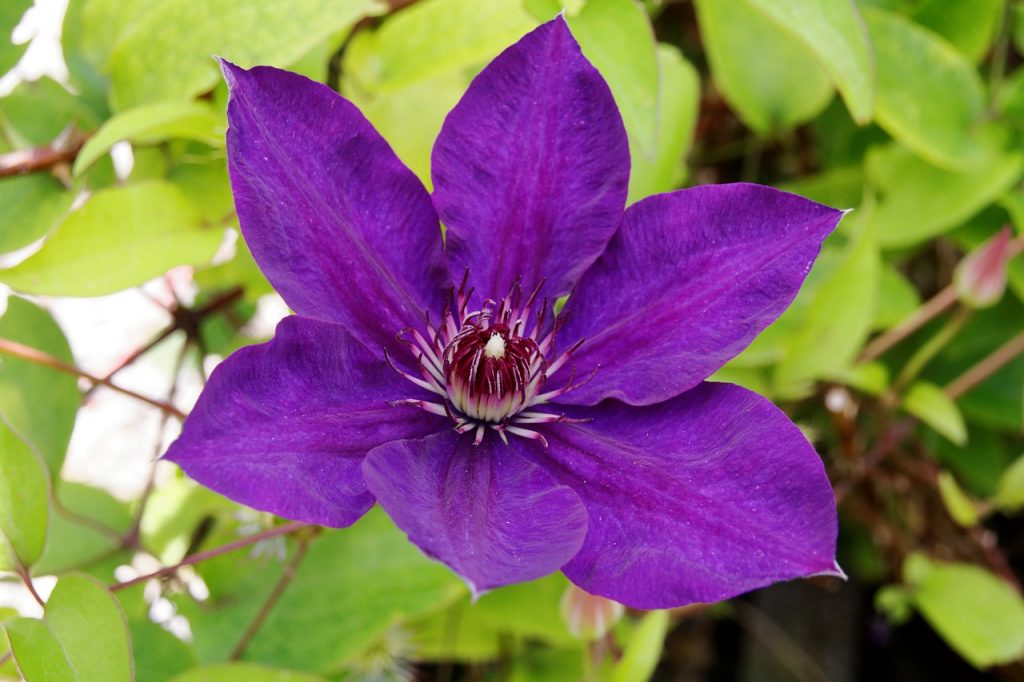
Clematis Gypsy Queen
Description of the variety
Gypsy Queen is a perennial plant belonging to the Jacquemann group. Climbing branches grow up to 4 m, internodes are located at a distance of 9-20 cm.The leaf plates are emerald, the contour of a lilac shade, in shape they are lanceolate or pointed-ovate, together with the petiole reach 28 cm in length, width - 17-19 cm.
The buds form at the top 5 nodes formed in the current season. The flowers are large enough, the diameter varies within 11-15 cm, less often 18. Colored in purple-violet color, the transverse stripe is pronounced. Do not fade in bright sun. Up to 20 inflorescences can be located on one shoot.
The flowering period occurs at the end of August and lasts until the first October frosts. After that, fruits are formed in the form of nuts up to 0.7 cm long and 0.5 cm wide.
Landing features
If you want to grow a healthy and outwardly attractive Clematis on your site, it should be borne in mind that he absolutely does not tolerate transplantation, therefore, it is necessary to take seriously the choice of a place that, according to all criteria, will meet the requirements of a flower.
Planting can be done both in spring, in summer or in autumn, especially if a seedling with a closed root system was purchased. However, it is worth taking into account the natural conditions:
- If the region is characterized by a cold climate, the optimal time for the procedure is the end of April or the first days of May.
- In the southern regions, the date is postponed to September / October.
Seat selection
The plant feels most comfortable in an area protected from the effects of drafts. At the same time, it is necessary that the culture receives enough sunlight, from which it will be shaded in the midday heat. In this regard, you should not place the seedling next to buildings and trees. In addition, this is due to the fact that after precipitation a large amount of unnecessary liquid gets on the bush.
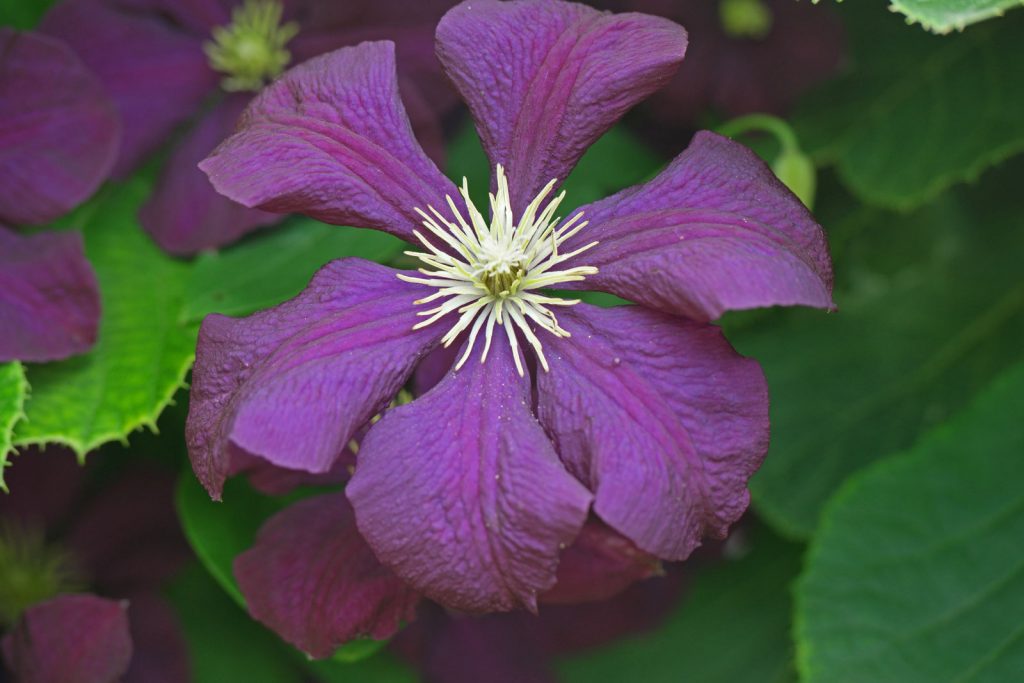
Clematis Gypsy Queen reviews
If the garden is located in a lowland, then a mound is artificially constructed, thereby increasing the distance to the underlying groundwater. The root system of Clematis is quite long (over 1 m) - if the roots are constantly in contact with moisture, the risk of decay and further death increases. Moreover, experienced gardeners recommend planting low-growing phloxes or any flowers of a similar type next to Gypsy Queen to shade the plants at the base.
The variety is not picky about the soil, but preference should still be given to light loams or sandy loam soil with plant humus included in the composition. The medium of the substrate also plays an important role - it must be neutral or slightly acidic. If the soil is alkaline on the site, then the situation is corrected by introducing peat, rotted spruce needles, urea or ammonium sulfate.
River sand is added to heavy clay soil to increase air and water permeability, and microelements are added to poor clay. In any case, before planting, the surface is dug to a depth of about 1 m.
Preparation of planting material
You can buy this variety of Clematis in almost any specialized store. When buying seedlings, you should carefully study the external condition of the aboveground part. If rooted one-year-old cuttings are offered for sale, at least 3 elastic roots must be present on it.
If it is necessary to keep the seedling for a certain time, the pot is placed on a sunny windowsill, the soil is disinfected with Phytosporin and fertilized once every 10 days with Biohumus.
If it is required to inspect the roots of a plant, but an earthen lump does not allow it, the flower is placed in warm water for a couple of hours. Also, some gardeners recommend dipping the rhizome in a clay mash before planting.
Landing technology
For several days before the procedure, the plant is hardened, having determined it still in the transport soil in the fresh air. Then they dig a volumetric hole measuring 60 * 60 * 60 cm.
Subsequent stages:
- A drainage 10-12 cm thick is laid out at the bottom from chipped bricks or gravel.
- A support is installed in the form of a fan, pyramid or arch made of strong material like a fine mesh. In this case, the liana-like culture should be located inside the structure.
- Peat, humus, turf, wood ash, mineral fertilizer (100 g per planting) are added to the soil mixture.
- Fill the depression halfway with earth, forming a mound. A plant is placed on top and the roots are straightened.
- The remaining space is filled with soil without deepening the lower growth bud. Additionally, a small bowl-like recess is left about 10 cm deep. To stimulate root formation throughout the summer, fertile soil is poured into the depression in several approaches.
- Water at the rate of 10 liters per bush.
- Mulch.
Care
Due to the fact that the culture is among the moisture-loving and has a sufficiently voluminous aboveground part, it is required to water the bush once a week.
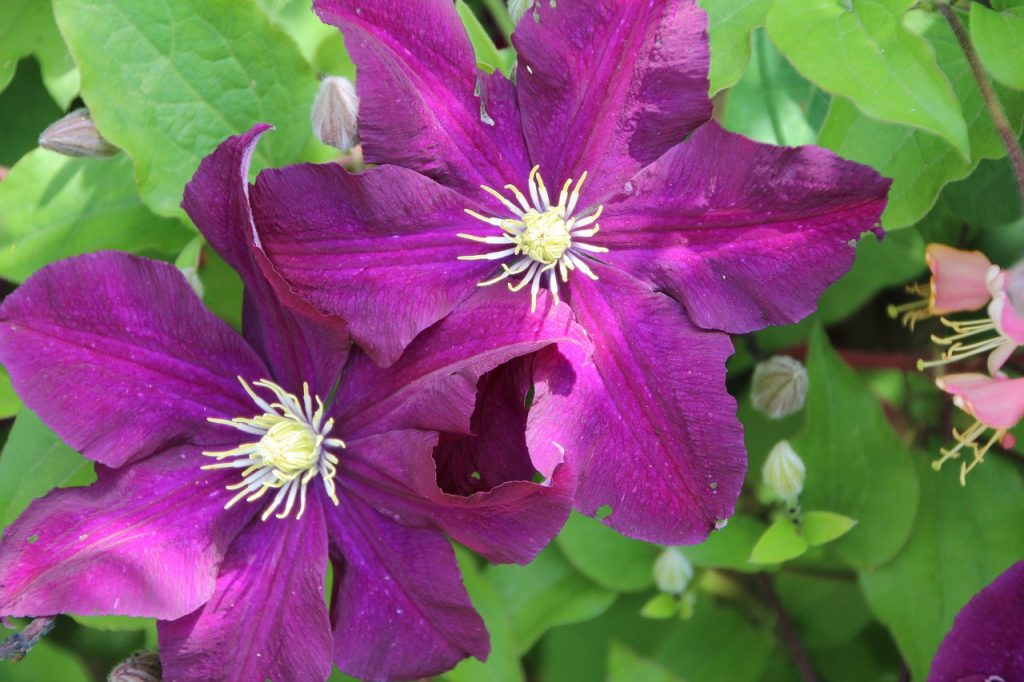
Reviews of Clematis Gypsy Queen
In a particularly dry summer, the frequency of the procedure is increased by 2-3 times. It is preferable to use water for irrigation settled and warm, at the rate of 1-2 buckets for a young plant, 3-4 for an adult.
Loosening is done only if the space at the base was not covered with mulch. Peat, wood chips or sawdust are used as materials for mulch. Additionally, the weed circle is carefully weeded.
Top dressing
In the first year of Clematis's life in a new place with dressings, it is better not to be zealous, in the future they are made depending on the stage of flower development:
- At the beginning of the growing season, nitrogen preparations are introduced.
- At the time of bud formation - potash.
- At the end of flowering - phosphoric.
Also, after pruning in the summer, it is fertilized with a mineral complex in a ratio of 20 g per 10 liters of water and a solution of copper sulfate, in the spring it is watered with milk of lime. In the flowering phase, the use of any fertilizers is completely abandoned.
Pruning
Gypsy Queen is a late-flowering clematis belonging to the 3rd pruning group, buds on it are formed only on young shoots of the current year. In this regard, the shrub needs a radical shearing in the fall to stimulate the formation of a new growth. Therefore, before the onset of cold weather, the plant is cut either almost at the root, or slightly higher.These manipulations ensure abundant flowering throughout the next season.
Shelter for the winter
In order to avoid freezing of the root system and the lower bud, the liana is covered for the winter - covered with sand or peat, a non-woven material is spread over it.
Reproduction
Clematis is propagated mainly by cuttings, the seed method leads to a loss of varietal characteristics. At the same time, the effectiveness of the procedure is 82% - cuttings of a liana-like shrub have a fairly high survival rate.
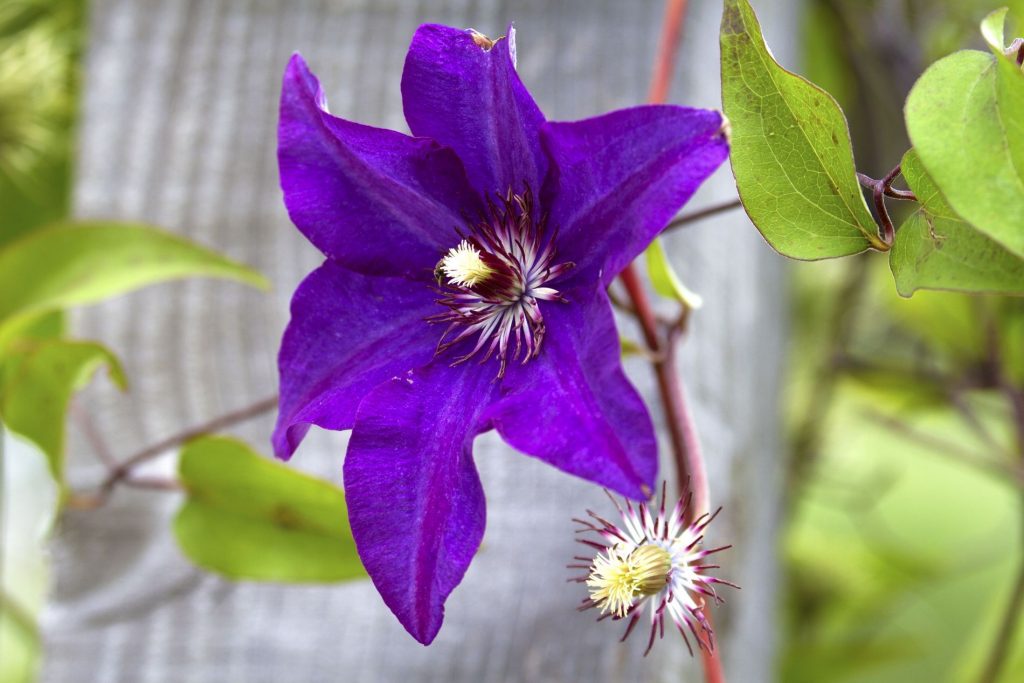
Clematis Gypsy Queen description
Shoots with two vegetative buds are cut in June-July, when the culture is in the budding stage. At the same time, no more than 3 segments are allowed to be taken from one bush. After the cuttings are kept for 7-10 hours in a biostimulator (naphthylacetic acid, heteroauxin) and placed in open boxes with a substrate. It is laid out in several layers: the lower one consists of humus and is 20-30 cm thick, the upper one is a mixture of sand and peat in equal proportions.
In the future, the young are regularly watered and sprayed. To speed up the process of root formation, it is allowed to stretch a film over the container, but this should be done with caution - the maximum temperature should not exceed 25 degrees.
One-year-olds are planted in open ground in the fall - in September-October, subject to the presence of at least 5 roots. Pre-still immature plants must be hardened, which will help them to adapt more quickly after planting.
Diseases and pests
Most cases of Clematis disease are caused by fungal infections. The bush exposed to them stops in development, blooms poorly, and often dies during wintering.
- Ascochitis. Among the symptoms are brown or black spots on the leaves, less often found at the base of the shoots of the plant. The affected areas are characterized by clear oval-shaped contours, grow over time, leading to the appearance of holes. For treatment, standard antifungal procedures are performed.
- Verticillary wilting. It is expressed in the darkening of the leaf plates and the complete loss of turgor in the branches. Solve the problem by eliminating injured segments with subsequent treatment with chemicals (Fitosporin-M, Maxim, KS)
- Phomopsis wilting. It looks like yellowish or brown single spots on the leaves located closer to the base of the flower, which then spread over the entire surface and additionally appear on the tips of the petals in the blossoming buds. For treatment, Previkur is used in combination with recreational activities.
- Rust. Most often occurs in the spring. Initiated by small swollen blotches with a red bloom. As the disease progresses, parts of the plant turn brown and quickly die off. They fight the disease by spraying with antifungal drugs.
- Gray rot. It manifests itself as brown spots with grayish hairiness. You can liquidate with copper sulfate in a composition with wood ash and chalk.
- Powdery mildew. At the first stage, the plant is covered with a white cotton-like bloom, which becomes darker over time. In this case, the leaves undergo deformation, die off. An effective way to combat the disease is considered to be spraying with mustard infusion, soda ash or salicylic acid with alcohol.
Clematis are most often susceptible to:
- to the bear;
- nematodes;
- spider mite;
- slugs;
- snails;
- aphids.
When signs of insect activity are detected, fungicidal or biological agents are used, such as Bitoxibacillin, Fitoverm, Vermitic.
As a prophylaxis against parasites and diseases, the standards of care in the spring are observed:
- Dispose of the winter layer of mulch, because spores of fungi and larvae can remain in it.
- In addition to root dressings, the aerial part is sprayed with fertilizers, increasing the proportion of water by half.
- They are treated with a 1% solution of Bordeaux liquid: green mass before the formation of buds, earth - every 14 days.
Use in landscape design
The attractive Gypsy Queen, when properly located, can perfectly decorate any, even the most unsightly building. Many flower growers plant crops next to gazebos, swings, fruit trees. If there is a reservoir on the territory, then Clematis will turn it into a luxurious decoration that will attract the eyes of neighbors.
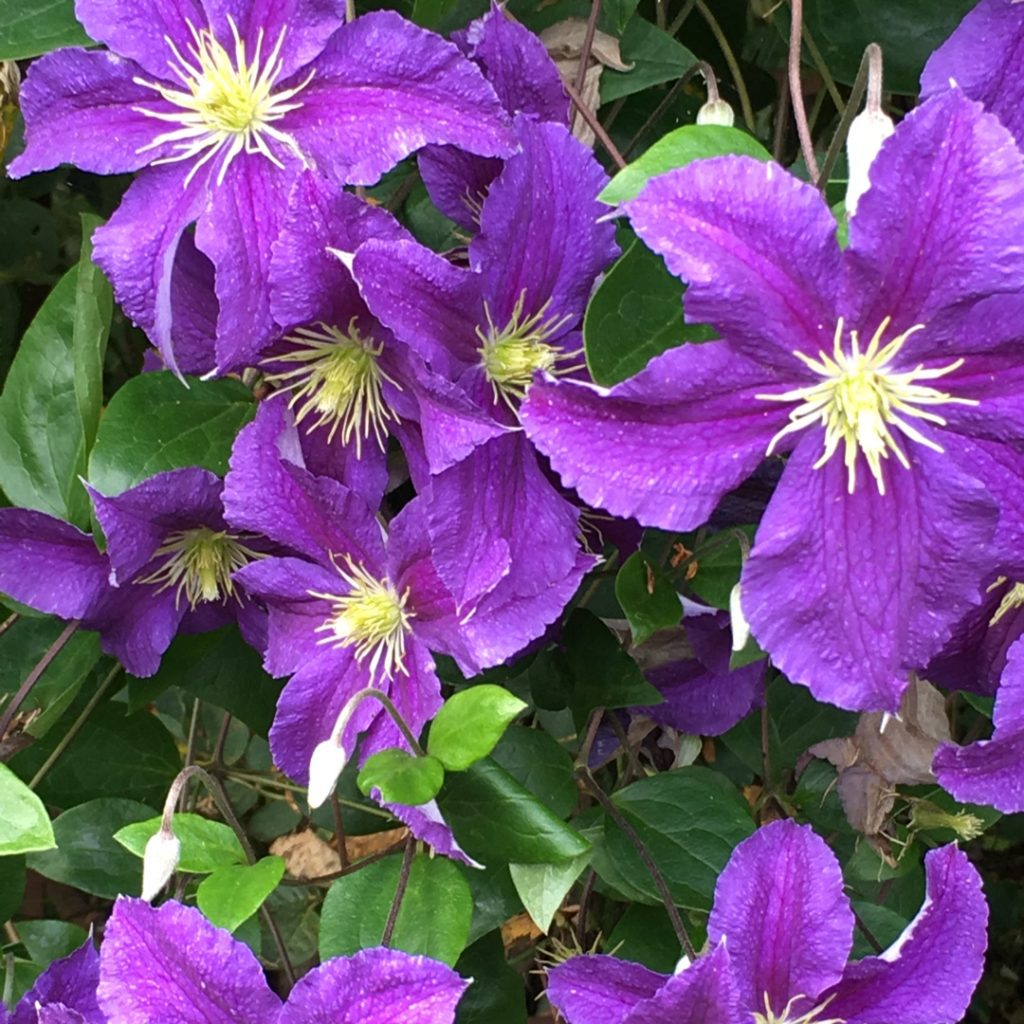
Clematis Gypsy Queen description and photo
Testimonials
Gardeners' opinions differ regarding this variety. The advantages of summer residents include the unpretentiousness of the shrub, good disease resistance, and a high degree of frost resistance. However, some are not satisfied with the principle of the formation of buds at the ends of the shoots, because they are located very high on adult specimens. However, on the forums you can find information based on personal experience on how to get out of this situation. In this case, it is advised to systematically redistribute the branches of the vines, lowering them lower.

